... newer stories
Mittwoch, 28. Februar 2018
Weather data from the January 2018 in Hamburg-Rissen
meadowkids.eu, 14:27h
The weather data include all Hamburg districts, and also Rissen. The dates are collected in Hamburg, district Fuhlsbüttel.
We´re planing to build our own weather station, but the software is tricky and gave us a lot complications, that is why, we can only use the data from the weather station in Fuhlsbüttel.
Next graphic show us the data of temperature from January.
The first highest peak follows from the lowest peaks oft the temperature.
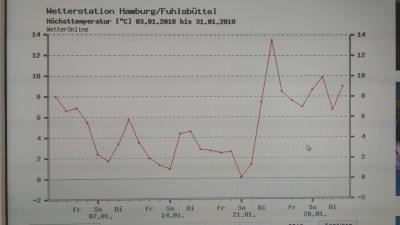
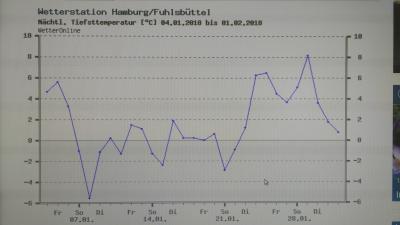
https://www.wetteronline.de/wetterdaten/hamburg?pcid=pc_rueckblick_data&gid=10147&pid=p_rueckblick_diagram&sid=StationHistory&iid=10147&month=01&year=2018&period=4&metparaid=RR24
The last graphic shows the peaks of rain in millimetre per square meter.
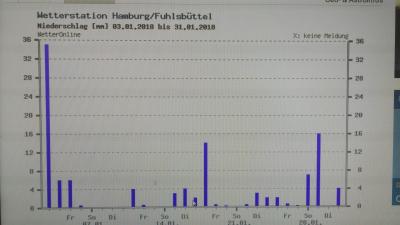
https://www.wetteronline.de/wetterdaten/hamburg?pcid=pc_rueckblick_data&gid=10147&pid=p_rueckblick_diagram&sid=StationHistory&iid=10147&month=01&year=2018&period=4&metparaid=RR24
If we look at the temperatures, we can see that with the low temperatures also came less rain.
The highest peaks of temperature, compare to January 2018, are 14 degree, in January 2008 are 12 degrees and in 1998 are 13 degrees. The temperature are from year to year raising. The highest temperature in 1998 is on most of the days around 0 degree or bellow it. In the following years the temperatures are going higher.
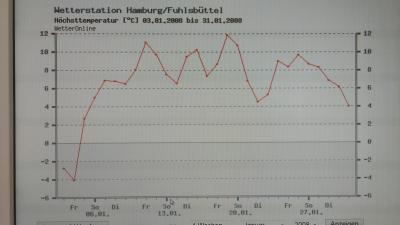
https://www.wetteronline.de/wetterdaten/hamburg?pcid=pc_rueckblick_data&gid=10147&pid=p_rueckblick_diagram&sid=StationHistory&iid=10147&metparaid=RR24&period=4&month=01&year=2008
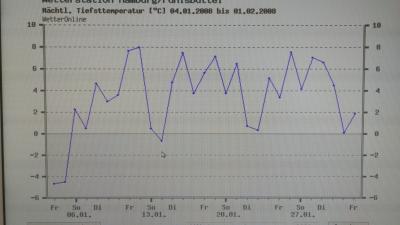
https://www.wetteronline.de/wetterdaten/hamburg?pcid=pc_rueckblick_data&gid=10147&pid=p_rueckblick_diagram&sid=StationHistory&iid=10147&metparaid=RR24&period=4&month=01&year=2008
If you look at the night temperature you will see that in January 2018 they lying between + 8 an -6 degree, in January 2008 between +8 and -4 degree an in January +6,5 and -11,5 degree. In the last 20 years the diverenz between the day and night temperature the high degrees take away from the lower degrees. The monthly shape of temperature graded up to 1,5 degree an the lowest by 5,5 degree.
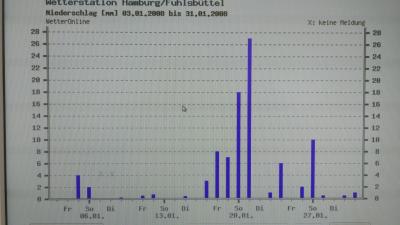
https://www.wetteronline.de/wetterdaten/hamburg?pcid=pc_rueckblick_data&gid=10147&pid=p_rueckblick_diagram&sid=StationHistory&iid=10147&metparaid=RR24&period=4&month=01&year=2008

https://www.wetteronline.de/wetterdaten/hamburg?pcid=pc_rueckblick_data&gid=10147&pid=p_rueckblick_diagram&sid=StationHistory&iid=10147&metparaid=RR24&period=4&month=01&year=1998

https://www.wetteronline.de/wetterdaten/hamburg?pcid=pc_rueckblick_data&gid=10147&pid=p_rueckblick_diagram&sid=StationHistory&iid=10147&metparaid=RR24&period=4&month=01&year=1998

https://www.wetteronline.de/wetterdaten/hamburg?pcid=pc_rueckblick_data&gid=10147&pid=p_rueckblick_diagram&sid=StationHistory&iid=10147&metparaid=RR24&period=4&month=01&year=1998
The precipitation show us only small differents. all years have compact a couple of day with precipitations. Ther e is a different between on which days. In the last ten year we get two more days with rain in January. The day with a high level of rain ar between 19 mm per squaremeter and 27mm. Possibly intersting is taht later days in month the precipitation get higher.
Shurely is that it`s was rain because the temperature are higher. Also are the temperature lower there are less decipitations.
We´re planing to build our own weather station, but the software is tricky and gave us a lot complications, that is why, we can only use the data from the weather station in Fuhlsbüttel.
Next graphic show us the data of temperature from January.
The first highest peak follows from the lowest peaks oft the temperature.


https://www.wetteronline.de/wetterdaten/hamburg?pcid=pc_rueckblick_data&gid=10147&pid=p_rueckblick_diagram&sid=StationHistory&iid=10147&month=01&year=2018&period=4&metparaid=RR24
The last graphic shows the peaks of rain in millimetre per square meter.

https://www.wetteronline.de/wetterdaten/hamburg?pcid=pc_rueckblick_data&gid=10147&pid=p_rueckblick_diagram&sid=StationHistory&iid=10147&month=01&year=2018&period=4&metparaid=RR24
If we look at the temperatures, we can see that with the low temperatures also came less rain.
The highest peaks of temperature, compare to January 2018, are 14 degree, in January 2008 are 12 degrees and in 1998 are 13 degrees. The temperature are from year to year raising. The highest temperature in 1998 is on most of the days around 0 degree or bellow it. In the following years the temperatures are going higher.

https://www.wetteronline.de/wetterdaten/hamburg?pcid=pc_rueckblick_data&gid=10147&pid=p_rueckblick_diagram&sid=StationHistory&iid=10147&metparaid=RR24&period=4&month=01&year=2008

https://www.wetteronline.de/wetterdaten/hamburg?pcid=pc_rueckblick_data&gid=10147&pid=p_rueckblick_diagram&sid=StationHistory&iid=10147&metparaid=RR24&period=4&month=01&year=2008
If you look at the night temperature you will see that in January 2018 they lying between + 8 an -6 degree, in January 2008 between +8 and -4 degree an in January +6,5 and -11,5 degree. In the last 20 years the diverenz between the day and night temperature the high degrees take away from the lower degrees. The monthly shape of temperature graded up to 1,5 degree an the lowest by 5,5 degree.

https://www.wetteronline.de/wetterdaten/hamburg?pcid=pc_rueckblick_data&gid=10147&pid=p_rueckblick_diagram&sid=StationHistory&iid=10147&metparaid=RR24&period=4&month=01&year=2008

https://www.wetteronline.de/wetterdaten/hamburg?pcid=pc_rueckblick_data&gid=10147&pid=p_rueckblick_diagram&sid=StationHistory&iid=10147&metparaid=RR24&period=4&month=01&year=1998

https://www.wetteronline.de/wetterdaten/hamburg?pcid=pc_rueckblick_data&gid=10147&pid=p_rueckblick_diagram&sid=StationHistory&iid=10147&metparaid=RR24&period=4&month=01&year=1998

https://www.wetteronline.de/wetterdaten/hamburg?pcid=pc_rueckblick_data&gid=10147&pid=p_rueckblick_diagram&sid=StationHistory&iid=10147&metparaid=RR24&period=4&month=01&year=1998
The precipitation show us only small differents. all years have compact a couple of day with precipitations. Ther e is a different between on which days. In the last ten year we get two more days with rain in January. The day with a high level of rain ar between 19 mm per squaremeter and 27mm. Possibly intersting is taht later days in month the precipitation get higher.
Shurely is that it`s was rain because the temperature are higher. Also are the temperature lower there are less decipitations.
... link (0 Kommentare) ... comment
Montag, 26. Februar 2018
Meteorological report for January
beekids, 18:37h
January is the central month of meteorological winter and is usually the coldest month of the year, which was not the case in January 2018, which was the third warmest January since the temperature has been measured in Slovenia. The situation in Maribor was the same, the maximum temperatures reached up to 16 °C.
The average monthly temperature was also significantly higher than the average of the period from 1981 to 2010, it was 2.87 °C and it was 2.97 °C higher than the long-term average. The long-term average for January is - 0.1 °C in Maribor.
In January, the average temperature was only four times below the freezing point (0 °C). Only one day the maximum temperature did not exceed 0 °C. The lowest temperature in January was only - 5.32 °C, and the highest temperature was 16.51 °C.

Precipitation data is reversed. Precipitation during January was above average. There were nine rainy days, with 44.4 mm of precipitation, which is 27 % more than the long-term average (35 mm of precipitation). Most precipitation fell on the first day of the year and in the period from 9 to 16 January.
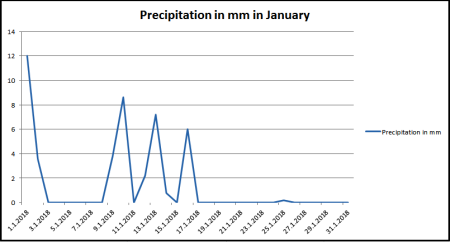
The average relative humidity in January was 85.28 %.

The average monthly temperature was also significantly higher than the average of the period from 1981 to 2010, it was 2.87 °C and it was 2.97 °C higher than the long-term average. The long-term average for January is - 0.1 °C in Maribor.
In January, the average temperature was only four times below the freezing point (0 °C). Only one day the maximum temperature did not exceed 0 °C. The lowest temperature in January was only - 5.32 °C, and the highest temperature was 16.51 °C.

Precipitation data is reversed. Precipitation during January was above average. There were nine rainy days, with 44.4 mm of precipitation, which is 27 % more than the long-term average (35 mm of precipitation). Most precipitation fell on the first day of the year and in the period from 9 to 16 January.

The average relative humidity in January was 85.28 %.

... link (0 Kommentare) ... comment
Meteorological report for Biotechnical School Maribor
beekids, 18:37h
At the school estate, we started observing the weather on 1 January, 2018. The meteorological station is set in the apple orchard in the middle of the school estate. On the southern and eastern side it is closed by blocks of flats, which represent the beginning of the city, and in the north by the hill Kalvarija.
The weather station is type A733 and has a basic set of sensors - sensor for measuring air temperature, relative humidity, precipitation sensor and wetness sensor. From the obtained data we can calculate the average temperature, the highest and the lowest daily temperature, the daily amount of precipitation and the average relative humidity. The data obtained will be compared with the data from the period from 1981 to 2010.
In addition to meteorological data, we will also monitor phenological phases of the plants (fruit trees, pumpkins, potatoes, etc.) and we will also photograph them.
The weather data and phenological phases will also be monitored in Hamburg. Thus, we can compare the development of weather and plants in two completely different locations.
The data will also be presented in graphic form.
We will publish the reports on the blog.
The weather station is type A733 and has a basic set of sensors - sensor for measuring air temperature, relative humidity, precipitation sensor and wetness sensor. From the obtained data we can calculate the average temperature, the highest and the lowest daily temperature, the daily amount of precipitation and the average relative humidity. The data obtained will be compared with the data from the period from 1981 to 2010.
In addition to meteorological data, we will also monitor phenological phases of the plants (fruit trees, pumpkins, potatoes, etc.) and we will also photograph them.
The weather data and phenological phases will also be monitored in Hamburg. Thus, we can compare the development of weather and plants in two completely different locations.
The data will also be presented in graphic form.
We will publish the reports on the blog.
... link (0 Kommentare) ... comment
Sonntag, 25. Februar 2018
Weather data from the past 20 years in the November and the December
meadowkids.eu, 17:09h
In the last year we had a lot of peaks of rainfall. On the 3rd of June we had 77,1 l water on a square meter. December 2017 in Hamburg had only 4 days without rain and in January 2018 we had also only 7 days degrees below 0.
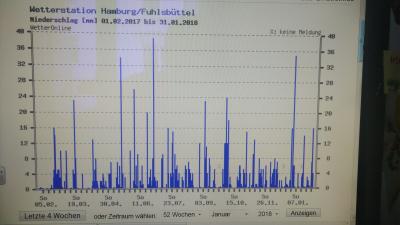
https://www.wetteronline.de/wetterdaten/hamburg?pcid=pc_rueckblick_data&gid=10147&pid=p_rueckblick_diagram&sid=StationHistory&iid=10147&month=01&year=2018&period=52&metparaid=RR24
The rainfall in this year was very unusual - the temperatures were higher for the December, also comparing with the last year. It`s warmer.
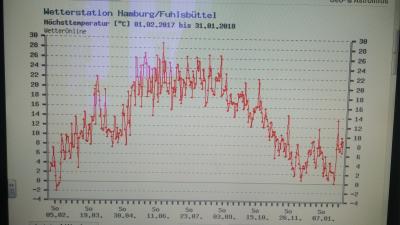
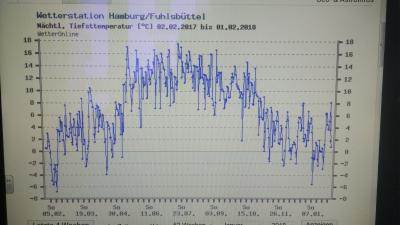
https://www.wetteronline.de/wetterdaten/hamburg?pcid=pc_rueckblick_data&gid=10147&pid=p_rueckblick_diagram&sid=StationHistory&iid=10147&month=01&year=2018&period=52&metparaid=TXLD
The following graphics will show your the temperatures of the last twenty years for the window from 7th of November to the 1st of January. It`s shows the winter from 2017/18, `15/`16, `14/`15,`07/`08 and `97/`98. Two things you will see over the years: The temperature gets more different peaks between high and low temperature per day. The other one is, that the peaks in 1997/98 only have 11 days over 10 degrees and often bellow 0 degree. In 2008 the most of the peaks have over 0 degree and only 16 day bellow. The difference between the highest and the lowest peaks per day are often far apart.
The last days in year 2018 we had a lot of rainy days, that lower the degrees, but we had rarely temperatures bellow 0 degree.
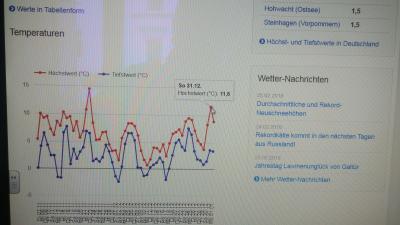
https://www.wetterkontor.de/de/wetter/deutschland/rueckblick.asp?id=80&datum=01.01.2018&t=8
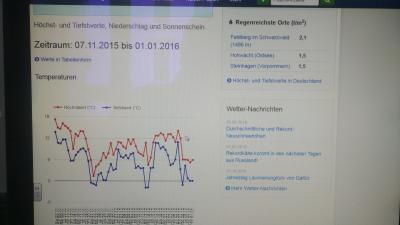
https://www.wetterkontor.de/de/wetter/deutschland/rueckblick.asp?id=80&datum=01.01.2016&t=8
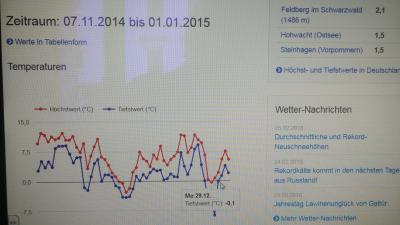
https://www.wetterkontor.de/de/wetter/deutschland/rueckblick.asp?id=80&datum=01.01.2015&t=8

https://www.wetterkontor.de/de/wetter/deutschland/rueckblick.asp?id=80&datum=01.01.2008&t=8
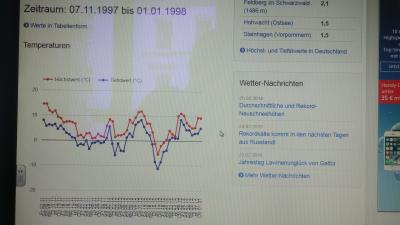
https://www.wetterkontor.de/de/wetter/deutschland/rueckblick.asp?id=80&datum=01.01.1998&t=8
The same phenomenon we can see by the rainy days in Hamburg. In the last twenty years we had regular compresses times and days with high level of the rain. In 1998 we had days with maximum rain with cca 10 Liter per square meter with peaks in three phases in the year. And one day with 14L of rain. In 2008 we have less days of rain (29) in compare to 1998 (31) in the same window of time. But in 2008 there is a highest peak with over 35 Liter per square meter.
In all the twenty years the rain was usually not higher than 10 L per square meter. In year 1998 the rain was around by 6 L and only one day by 12 Liter.
In the last winter we had 42 days of rain in our window of time and five days over or by 10 l per square meter.
Like we can see on the graphic, we had more rain than al the last twenty years or the days with the highest temperatures!
We can see, that the climate is changing.
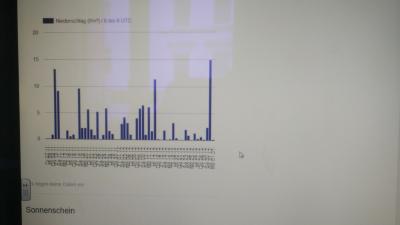
https://www.wetterkontor.de/de/wetter/deutschland/rueckblick.asp?id=80&datum=01.01.2018&t=8

https://www.wetterkontor.de/de/wetter/deutschland/rueckblick.asp?id=80&datum=01.01.2016&t=8

https://www.wetterkontor.de/de/wetter/deutschland/rueckblick.asp?id=80&datum=01.01.2015&t=8
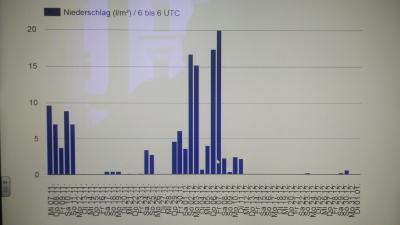
https://www.wetterkontor.de/de/wetter/deutschland/rueckblick.asp?id=80&datum=01.01.2008&t=8

https://www.wetterkontor.de/de/wetter/deutschland/rueckblick.asp?id=80&datum=01.01.1998&t=8
All the graphics show us, that the average temperature raise up over the years. And the rainy days follows the highest level amount of water.
This climate makes it possible, that pumpkins and vine from Slovenia would also grow in Hamburg.

https://www.wetteronline.de/wetterdaten/hamburg?pcid=pc_rueckblick_data&gid=10147&pid=p_rueckblick_diagram&sid=StationHistory&iid=10147&month=01&year=2018&period=52&metparaid=RR24
The rainfall in this year was very unusual - the temperatures were higher for the December, also comparing with the last year. It`s warmer.


https://www.wetteronline.de/wetterdaten/hamburg?pcid=pc_rueckblick_data&gid=10147&pid=p_rueckblick_diagram&sid=StationHistory&iid=10147&month=01&year=2018&period=52&metparaid=TXLD
The following graphics will show your the temperatures of the last twenty years for the window from 7th of November to the 1st of January. It`s shows the winter from 2017/18, `15/`16, `14/`15,`07/`08 and `97/`98. Two things you will see over the years: The temperature gets more different peaks between high and low temperature per day. The other one is, that the peaks in 1997/98 only have 11 days over 10 degrees and often bellow 0 degree. In 2008 the most of the peaks have over 0 degree and only 16 day bellow. The difference between the highest and the lowest peaks per day are often far apart.
The last days in year 2018 we had a lot of rainy days, that lower the degrees, but we had rarely temperatures bellow 0 degree.

https://www.wetterkontor.de/de/wetter/deutschland/rueckblick.asp?id=80&datum=01.01.2018&t=8

https://www.wetterkontor.de/de/wetter/deutschland/rueckblick.asp?id=80&datum=01.01.2016&t=8

https://www.wetterkontor.de/de/wetter/deutschland/rueckblick.asp?id=80&datum=01.01.2015&t=8

https://www.wetterkontor.de/de/wetter/deutschland/rueckblick.asp?id=80&datum=01.01.2008&t=8

https://www.wetterkontor.de/de/wetter/deutschland/rueckblick.asp?id=80&datum=01.01.1998&t=8
The same phenomenon we can see by the rainy days in Hamburg. In the last twenty years we had regular compresses times and days with high level of the rain. In 1998 we had days with maximum rain with cca 10 Liter per square meter with peaks in three phases in the year. And one day with 14L of rain. In 2008 we have less days of rain (29) in compare to 1998 (31) in the same window of time. But in 2008 there is a highest peak with over 35 Liter per square meter.
In all the twenty years the rain was usually not higher than 10 L per square meter. In year 1998 the rain was around by 6 L and only one day by 12 Liter.
In the last winter we had 42 days of rain in our window of time and five days over or by 10 l per square meter.
Like we can see on the graphic, we had more rain than al the last twenty years or the days with the highest temperatures!
We can see, that the climate is changing.

https://www.wetterkontor.de/de/wetter/deutschland/rueckblick.asp?id=80&datum=01.01.2018&t=8

https://www.wetterkontor.de/de/wetter/deutschland/rueckblick.asp?id=80&datum=01.01.2016&t=8

https://www.wetterkontor.de/de/wetter/deutschland/rueckblick.asp?id=80&datum=01.01.2015&t=8

https://www.wetterkontor.de/de/wetter/deutschland/rueckblick.asp?id=80&datum=01.01.2008&t=8

https://www.wetterkontor.de/de/wetter/deutschland/rueckblick.asp?id=80&datum=01.01.1998&t=8
All the graphics show us, that the average temperature raise up over the years. And the rainy days follows the highest level amount of water.
This climate makes it possible, that pumpkins and vine from Slovenia would also grow in Hamburg.
... link (0 Kommentare) ... comment
Samstag, 24. Februar 2018
Cold pressed pumpkin oil
beekids, 15:42h
Pumpkin seeds we picked and dried in the autumn. In the winter we tried to get our own pumpkin oil. For this we bought a little handy kitchen oil press. The press was properly constructed, connected to the mains and slightly warmed. Then the seeds were put into the funnel of oil press. We closed the funnel with the lid and pressed start button. Oil press started to work. We got the pumpkin oil and separately pumpkin tropines.

Why is cold pressed pumpkin oil so good for our skin?
Packed with essential fatty acids, vitamins, minerals, antioxidants, and more, the oil from pumpkin seeds helps soothe, hydrate, protect, and renew your look—making it a great ingredient for anti-aging formulas. The natural nutrients in pumpkin seeks, particularly zinc and vitamin C, help firm and tighten. That same zinc along with natural selenium helps with oily skin, helping it to look healthy and clean. A rich source of vitamin E, which is a potent antioxidant, pumpkin seed oil protects skin from environmental stressors. The essential fatty acids sink deeply into skin to provide long-lasting moisturization without greasiness. These acids also help balance oil, moisturizing dry skin and controlling oily skin. Natural properties of pumpkin seed work great with sensitive skin.
Which cosmetics products we made from cold pressed pumpkin oil?
Pumpkin soap
We melted coconut oil and added pumpkin and sunflower oil.
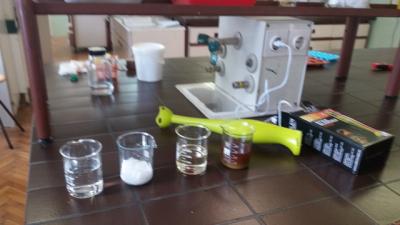
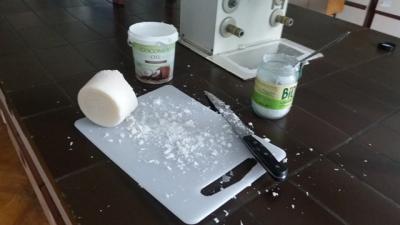
We warmed up this mixture for a while. In the meantime we added sodium hydroxide to the hydrolate. When this mixture has the same temperature as the oils, we mixed them together. We added also some ground pumpkin seeds.
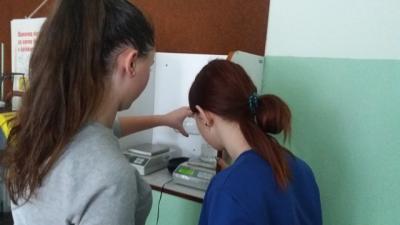
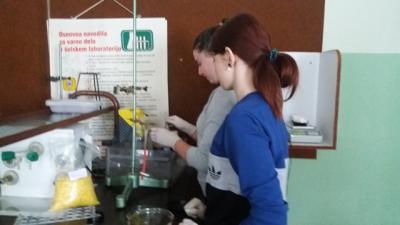
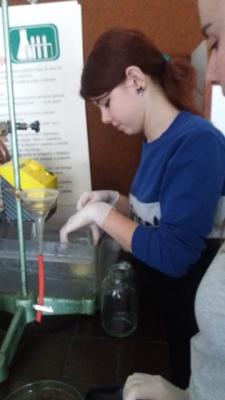
When the mass was like a puding we filled it in a soap models.

We wait three days, than we took soaps out of models. We must leave soaps 6 week to mature.
Pumpkin lip balm
To pumpkin oil we can add olive oil or cocconut oil. We melted all thise oils and added some wax. We poured it in lip balm tubes and waited that they solidify.

Nursing tablets
For them we melted wax an than added him caccao butter and pumpkin oil. We can add this mass also some esential oils and ground pumpkin seeds. We filled the mass in the models and wait that it solidify.
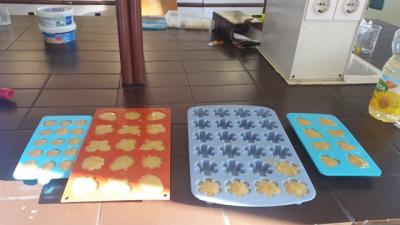
We can use this tablets after showering.
What are other advantages and effects of pumpkin oil?
Cold pressed pumpkin oil has a very beneficial effect on the function of the male prostate.
The oil is rich in a high content of delta-7-sterols that works against prostate enlargement (1g of oil contains 5 mg). Unsaturated fatty acids in conjunction with other substances have a positive effect on the metabolism of helostorel.

Why is cold pressed pumpkin oil so good for our skin?
Packed with essential fatty acids, vitamins, minerals, antioxidants, and more, the oil from pumpkin seeds helps soothe, hydrate, protect, and renew your look—making it a great ingredient for anti-aging formulas. The natural nutrients in pumpkin seeks, particularly zinc and vitamin C, help firm and tighten. That same zinc along with natural selenium helps with oily skin, helping it to look healthy and clean. A rich source of vitamin E, which is a potent antioxidant, pumpkin seed oil protects skin from environmental stressors. The essential fatty acids sink deeply into skin to provide long-lasting moisturization without greasiness. These acids also help balance oil, moisturizing dry skin and controlling oily skin. Natural properties of pumpkin seed work great with sensitive skin.
Which cosmetics products we made from cold pressed pumpkin oil?
Pumpkin soap
We melted coconut oil and added pumpkin and sunflower oil.


We warmed up this mixture for a while. In the meantime we added sodium hydroxide to the hydrolate. When this mixture has the same temperature as the oils, we mixed them together. We added also some ground pumpkin seeds.



When the mass was like a puding we filled it in a soap models.

We wait three days, than we took soaps out of models. We must leave soaps 6 week to mature.
Pumpkin lip balm
To pumpkin oil we can add olive oil or cocconut oil. We melted all thise oils and added some wax. We poured it in lip balm tubes and waited that they solidify.

Nursing tablets
For them we melted wax an than added him caccao butter and pumpkin oil. We can add this mass also some esential oils and ground pumpkin seeds. We filled the mass in the models and wait that it solidify.

We can use this tablets after showering.
What are other advantages and effects of pumpkin oil?
Cold pressed pumpkin oil has a very beneficial effect on the function of the male prostate.
The oil is rich in a high content of delta-7-sterols that works against prostate enlargement (1g of oil contains 5 mg). Unsaturated fatty acids in conjunction with other substances have a positive effect on the metabolism of helostorel.
... link (0 Kommentare) ... comment
Honey soap, Propolis soap and Propolis ointment
beekids, 15:27h
Honey is a popular additive for soap. It has various properties that make it appealing for skincare. Honey contains superior antibacterial, probiotic, and healing properties and is super nourishing and hydrating. If you have any skin care ailments ranging from eczema to acne, honey can help heal them as well as minor wounds.
Propolis contains antioxidant flavonoids, such as quercetin, pinocembrin, galangin and pinobanksin. Other compounds which are found in Propolis include; caffeic acid and hydroquinone, which are among the best known compounds used in most commercial cosmetic formulas to treat acne and other skin related infections. Propolis also contain minerals, such as magnesium, calcium, nickel and zinc, which are beneficial in rebuilding damaged skin cells, as well as giving you nourished, soft skin. Propolis can be used in the treatment and cure of acne. Propolis is also ideal in removing inflammations which cause bacteria responsible for the formation of nodules on your skin.
For honey soap we were melting glyceine base in a water bath. When it was melted we added wax and when it was melted we added honey. We mixed everythin well and added five droplets of essential oil of lavender. The resulting mass was poured into the soap models. We waited one day, than we putted soaps from models.
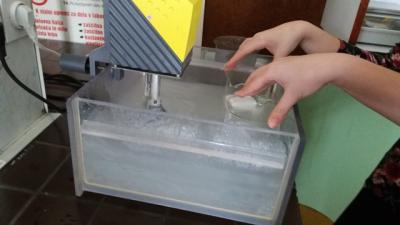
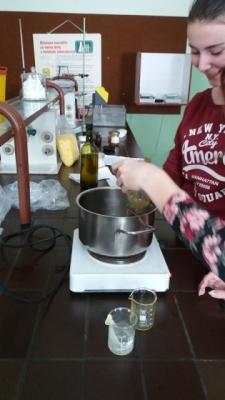
For propolis soap we were melting glycerine base in a water bath. In a water bath we were also heating the propolis tincture, so that the most of alcohol evaporated from it. We heated the honey to 45°C. We added propolis and honey to the malted glycerin, mixed it well and poured it into soap models. We waiting one day, than we putted soaps from models.
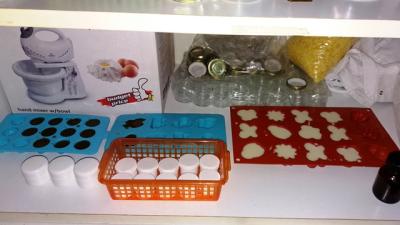
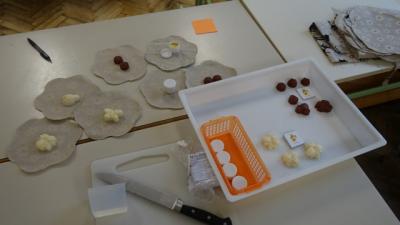
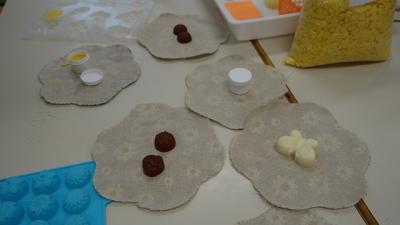
For propolis ointment we were heating separately honey, olive oil, wax, propolis tincture. Than we mixed everything together and poured it into storage jars while it was still warm. To avoid condensation allow the ointment to cool completely before securing with a lid.
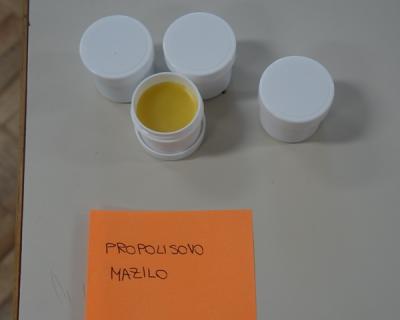
Propolis contains antioxidant flavonoids, such as quercetin, pinocembrin, galangin and pinobanksin. Other compounds which are found in Propolis include; caffeic acid and hydroquinone, which are among the best known compounds used in most commercial cosmetic formulas to treat acne and other skin related infections. Propolis also contain minerals, such as magnesium, calcium, nickel and zinc, which are beneficial in rebuilding damaged skin cells, as well as giving you nourished, soft skin. Propolis can be used in the treatment and cure of acne. Propolis is also ideal in removing inflammations which cause bacteria responsible for the formation of nodules on your skin.
For honey soap we were melting glyceine base in a water bath. When it was melted we added wax and when it was melted we added honey. We mixed everythin well and added five droplets of essential oil of lavender. The resulting mass was poured into the soap models. We waited one day, than we putted soaps from models.


For propolis soap we were melting glycerine base in a water bath. In a water bath we were also heating the propolis tincture, so that the most of alcohol evaporated from it. We heated the honey to 45°C. We added propolis and honey to the malted glycerin, mixed it well and poured it into soap models. We waiting one day, than we putted soaps from models.



For propolis ointment we were heating separately honey, olive oil, wax, propolis tincture. Than we mixed everything together and poured it into storage jars while it was still warm. To avoid condensation allow the ointment to cool completely before securing with a lid.

... link (0 Kommentare) ... comment
Creamed honey
beekids, 15:17h
Creamed honey is thicker and "creamier" than standard honey. It tastes better, feels like velvet on your tongue and won't smoosh out of your sandwich so much.
Contrary to popular belief, creamed honey is not whipped such us whipped cream. It is actually crystalized. The difference between creamed honey and the nasty, gritty honey is the size of the crystals. Creamed honey has tiny, silky, smooth crystals.
How we made it?
First we need a mixer for dough with a pot. We filled it with honey. We added two spoons of crystallized honey and mixed this mixture. We mixed it for 15 minutes, than we cooled it and wait one hour, than we mixed it again for 15 minutes. We repeated that three days during the day. After three days we added the mixture polen, royal jelly and propolis.
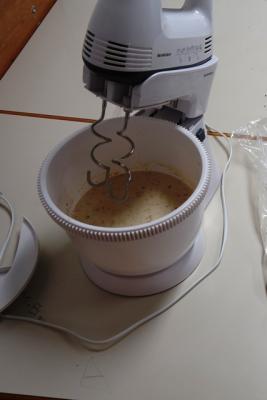
We mixed it 15 minutes and filled it in glasses.
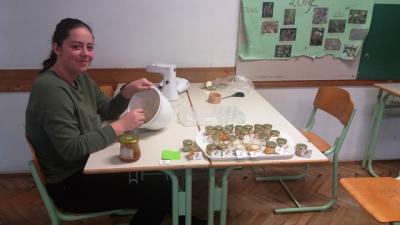

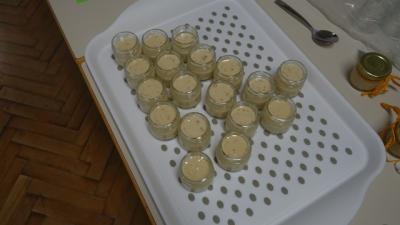
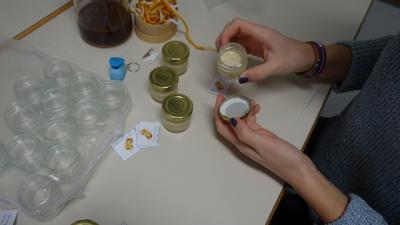
We putted the glasses in a fridge.
Contrary to popular belief, creamed honey is not whipped such us whipped cream. It is actually crystalized. The difference between creamed honey and the nasty, gritty honey is the size of the crystals. Creamed honey has tiny, silky, smooth crystals.
How we made it?
First we need a mixer for dough with a pot. We filled it with honey. We added two spoons of crystallized honey and mixed this mixture. We mixed it for 15 minutes, than we cooled it and wait one hour, than we mixed it again for 15 minutes. We repeated that three days during the day. After three days we added the mixture polen, royal jelly and propolis.

We mixed it 15 minutes and filled it in glasses.




We putted the glasses in a fridge.
... link (0 Kommentare) ... comment
Samstag, 3. Februar 2018
Beekeeping in January
beekids, 16:11h
When the weather was warming and the temperatures reached about 10 degrees, we observed a bee trip from the hives. Bees flew from all our hives. Some of them already carried pollen. Most likely it was the pollen of hazel trees that bloom in the surrounding area.
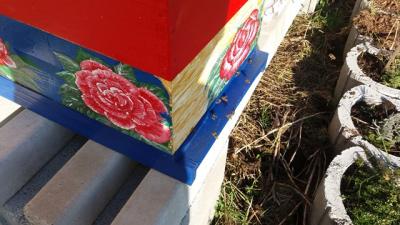
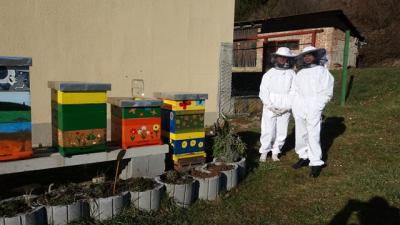
Because the temperature was appropriate, we began working in the bee garden. Our tractor driver Marko brought wooden beams for the pergola, which will support climbing plants.
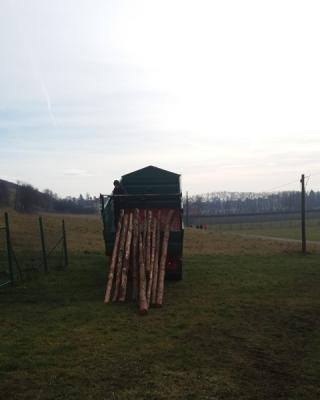
We planted Prunus avium, Erica carnea, Viburnum plicatum `Shasta`, Hedera helix, Vine (Isabella).
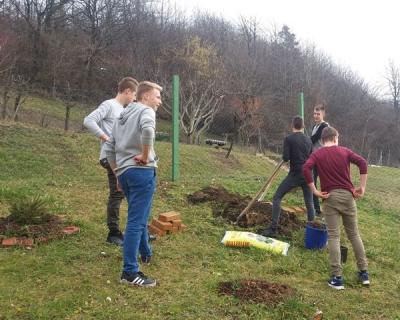
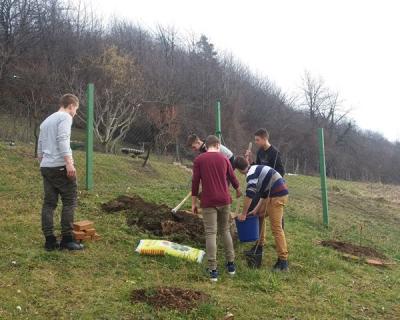
Girls sowed flower seeds into pots.
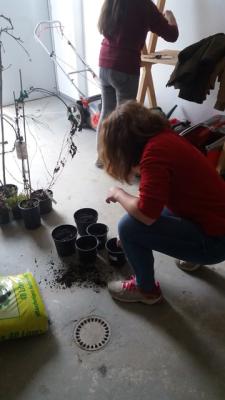
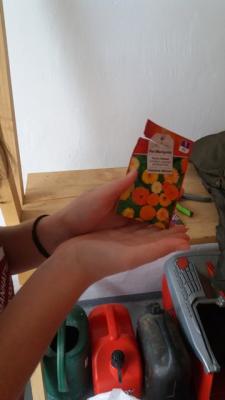
They also transplanted Parthenocissus quinquefolia and Clematis montana into larger pots. When the wooden pergola is finished, we will plant them outside.
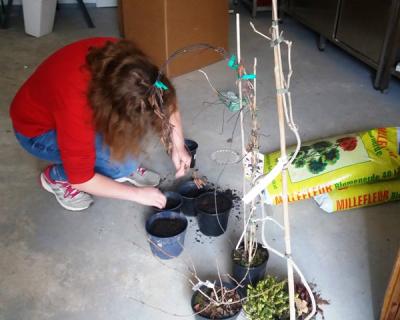

Some students dug the soil and prepared it for planting. They filled the wooden pallet with compost.
We got new hives and we will prepare them for new bee colonies.
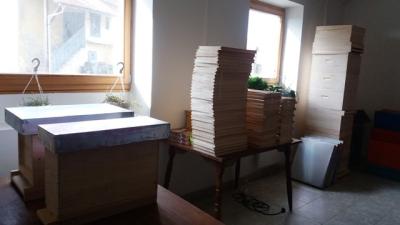


Because the temperature was appropriate, we began working in the bee garden. Our tractor driver Marko brought wooden beams for the pergola, which will support climbing plants.

We planted Prunus avium, Erica carnea, Viburnum plicatum `Shasta`, Hedera helix, Vine (Isabella).


Girls sowed flower seeds into pots.


They also transplanted Parthenocissus quinquefolia and Clematis montana into larger pots. When the wooden pergola is finished, we will plant them outside.


Some students dug the soil and prepared it for planting. They filled the wooden pallet with compost.
We got new hives and we will prepare them for new bee colonies.

... link (0 Kommentare) ... comment
Dienstag, 23. Januar 2018
Propolis tincture
beekids, 09:51h
What is propolis?
Consider bee propolis to be the “glue” that keeps everything together.
Initially, for propolis was thought to provide protection to the hive (e.g. rain, cold winds, snow). But protection is not only purpose of propolis, additionally it helps: reinforce hive structure and stability, minimize disruptive vibrations, prevent diseases and parasites from infecting the hives and mummify small intruders inside the hive.
Propolis is typically a mixture resin, composed of beeswax, saliva, sap and various botanical products in the surrounding area.
Propolis natural composition offers human an array of benefits when incorporated into a regular diet.
How did we collect propolis and make propolis tincture?
1. After we took honey out of hives, we laid propolis meshes in the hives. After one month we took them out of hives and put them into the freezer.
2. In January we decided to make propolis tincture.
3. We took propolis meshes from the freezer.
4. We scraped propolis out of the meshes with a knife.
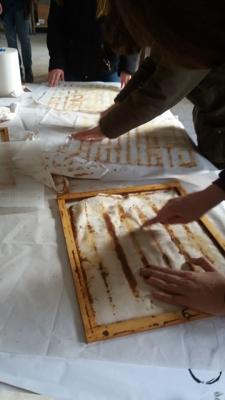
5. We placed propolis in the freezer and broke it in small pieces.
6. We ground propolis in a coffee grinder.

7. We put the propolis powder in a bottle and added alcohol. We added 300 ml of 98 % ethanol to 100 g of propolis. We shook it well.
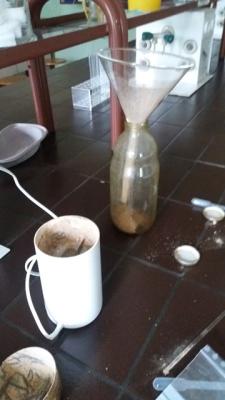
8. We stored the bottle in the darkness for about two weeks and shook it occasionally.
9. We filtered the tincture through a paper filter.


10. In a water bath we evaporated some ethanol.
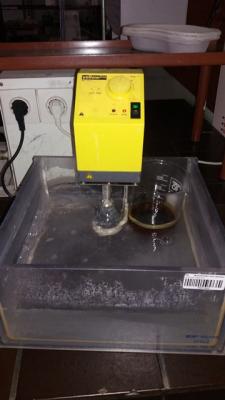
11. We stored the tincture closed in a clean dark bottle.
What are the effects of propolis on humans and in which diseases can it be used?
1. Propolis kills bacteria (Propolis has traditionally been used to kill colds and flu).
2. Propolis lowers blood pressure (If you suffer from hypertension, you may want to consider using raw honey, which contains propolis, as it has been proven to lower blood pressure.)
3. Propolis helps treat bone diseases (Another health benefit of propolis appears to be that it helps to build and maintain healthy bone tissue.)
4. Propolis helps treat allergies (An amazing health benefit of propolis is its ability to calm the symptoms of seasonal allergies.)
5. Propolis boosts prostate cancer cell death (Scientists examined the cancer killing effects of propolis tincture on two common types of prostate cancer. They concluded that propolis tincture markedly improved cell death in prostate cancer cells and suggested the significant role of propolis in chemoprevention of prostate cancer.)
6. Propolis kills colon cancer cells (Scientists found out that it caused the cancer cells to die by necrosis, which means that it interrupted the blood supply to the cell and caused just the local cancer cells to die and NOT healthy, living cells.)
7. Propolis may help treat food poisoning (Scientists found out that propolis inhibited the growth of C. jejuni, Enterobacter faecalis, and Staphylococcus aureus, the three bugs that are commonly found in food poisoning cases.)
8. Propolis protects injured teeth (It works against bacteria on teeth.)
9. Heat stress & athletic performance (An active ingredient in propolis known as caffeic acid phenethyl ester, or CAPE, triggers a broad spectrum of biological activities including antioxidant, anti-inflammatory and antiviral.)
10. Propolis is Effective Means Treatment for Warts (Propolis tincture killed a wart in less than two weeks.)
Propolis can affect very strong anti-inflammatory activity in many areas of the body. Inflammation is responsible for diseases such as arthritis, heart disease, Alzheimers, and many more. Much of the recent research indicates that one of the primary health benefits of propolis is its anti-inflammatory effects.
Chances are that people who consume propolis on a regular basis have less inflammation in their bodies and ultimately less disease, leading to healthier, longer lives.
Consider bee propolis to be the “glue” that keeps everything together.
Initially, for propolis was thought to provide protection to the hive (e.g. rain, cold winds, snow). But protection is not only purpose of propolis, additionally it helps: reinforce hive structure and stability, minimize disruptive vibrations, prevent diseases and parasites from infecting the hives and mummify small intruders inside the hive.
Propolis is typically a mixture resin, composed of beeswax, saliva, sap and various botanical products in the surrounding area.
Propolis natural composition offers human an array of benefits when incorporated into a regular diet.
How did we collect propolis and make propolis tincture?
1. After we took honey out of hives, we laid propolis meshes in the hives. After one month we took them out of hives and put them into the freezer.
2. In January we decided to make propolis tincture.
3. We took propolis meshes from the freezer.
4. We scraped propolis out of the meshes with a knife.

5. We placed propolis in the freezer and broke it in small pieces.
6. We ground propolis in a coffee grinder.

7. We put the propolis powder in a bottle and added alcohol. We added 300 ml of 98 % ethanol to 100 g of propolis. We shook it well.

8. We stored the bottle in the darkness for about two weeks and shook it occasionally.
9. We filtered the tincture through a paper filter.


10. In a water bath we evaporated some ethanol.

11. We stored the tincture closed in a clean dark bottle.
What are the effects of propolis on humans and in which diseases can it be used?
1. Propolis kills bacteria (Propolis has traditionally been used to kill colds and flu).
2. Propolis lowers blood pressure (If you suffer from hypertension, you may want to consider using raw honey, which contains propolis, as it has been proven to lower blood pressure.)
3. Propolis helps treat bone diseases (Another health benefit of propolis appears to be that it helps to build and maintain healthy bone tissue.)
4. Propolis helps treat allergies (An amazing health benefit of propolis is its ability to calm the symptoms of seasonal allergies.)
5. Propolis boosts prostate cancer cell death (Scientists examined the cancer killing effects of propolis tincture on two common types of prostate cancer. They concluded that propolis tincture markedly improved cell death in prostate cancer cells and suggested the significant role of propolis in chemoprevention of prostate cancer.)
6. Propolis kills colon cancer cells (Scientists found out that it caused the cancer cells to die by necrosis, which means that it interrupted the blood supply to the cell and caused just the local cancer cells to die and NOT healthy, living cells.)
7. Propolis may help treat food poisoning (Scientists found out that propolis inhibited the growth of C. jejuni, Enterobacter faecalis, and Staphylococcus aureus, the three bugs that are commonly found in food poisoning cases.)
8. Propolis protects injured teeth (It works against bacteria on teeth.)
9. Heat stress & athletic performance (An active ingredient in propolis known as caffeic acid phenethyl ester, or CAPE, triggers a broad spectrum of biological activities including antioxidant, anti-inflammatory and antiviral.)
10. Propolis is Effective Means Treatment for Warts (Propolis tincture killed a wart in less than two weeks.)
Propolis can affect very strong anti-inflammatory activity in many areas of the body. Inflammation is responsible for diseases such as arthritis, heart disease, Alzheimers, and many more. Much of the recent research indicates that one of the primary health benefits of propolis is its anti-inflammatory effects.
Chances are that people who consume propolis on a regular basis have less inflammation in their bodies and ultimately less disease, leading to healthier, longer lives.
... link (0 Kommentare) ... comment
Freitag, 19. Januar 2018
Herbal preparation against parasites
beekids, 14:49h
In the summer we collected and dried various herbs at school garden and at home.


In the cold winter days, students with their teachers cooked and distilled domestic spirit (Schnaps).
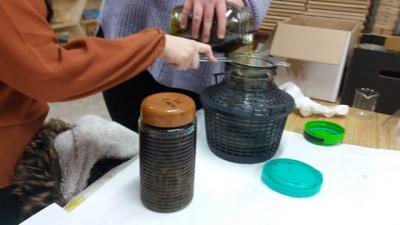
When everything was ready we decided to make herbal preparation against parasites.

Twelve herbs were used for the herbal preparation: peppermint (Mentha piperita), fennel (Foeniculum vulgare), thyme (Thymus vulgaris), goose grass (Galium aparine), chamomile (Chamomilla recutita), cayenne pepper (Capsicum frutescens), garlic (Allium sativum), wormwood (Artemisia absinthium), ginger (Zingiber officinale), cinnamon (Cinnamonum zeylanicum), fenugreek (Trigonella foenum-graecum) and liquorice (Glycyrrhiza glabra). The herbs were soaked in school brandy and filtered after one month. Some alcohol was later removed and honey with water (1:1) and propolis tincture was added to the preparation.
Animals can receive the herbal preparation orally at a dose of 0.1ml/kg of body weight for 5 days. The preparation eliminates internal parasites in animals, such as worms (helminths), tapeworms and protozoans.
The preparation is the result of the research work of our students. We also made a joint research of preparation with the Veterinary Faculty.


In the cold winter days, students with their teachers cooked and distilled domestic spirit (Schnaps).

When everything was ready we decided to make herbal preparation against parasites.

Twelve herbs were used for the herbal preparation: peppermint (Mentha piperita), fennel (Foeniculum vulgare), thyme (Thymus vulgaris), goose grass (Galium aparine), chamomile (Chamomilla recutita), cayenne pepper (Capsicum frutescens), garlic (Allium sativum), wormwood (Artemisia absinthium), ginger (Zingiber officinale), cinnamon (Cinnamonum zeylanicum), fenugreek (Trigonella foenum-graecum) and liquorice (Glycyrrhiza glabra). The herbs were soaked in school brandy and filtered after one month. Some alcohol was later removed and honey with water (1:1) and propolis tincture was added to the preparation.
Animals can receive the herbal preparation orally at a dose of 0.1ml/kg of body weight for 5 days. The preparation eliminates internal parasites in animals, such as worms (helminths), tapeworms and protozoans.
The preparation is the result of the research work of our students. We also made a joint research of preparation with the Veterinary Faculty.
... link (0 Kommentare) ... comment
Donnerstag, 18. Januar 2018
Presentation of international student exchange
beekids, 23:46h
Students who attended the international exchange in Hamburg prepared a presentation for students at school. We showed what we saw, everyone presented what he was doing at the workshops. We highlighted what we liked the most at the exchange. We impressed the students with beautiful photographs and with positive impressions of Hamburg, Stadtteilschule Rissen school and their students.
We all hope to visit Hamburg again.

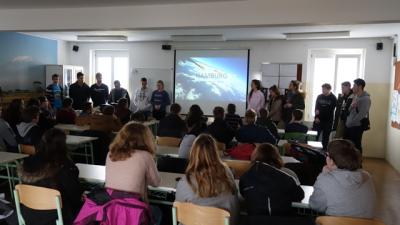
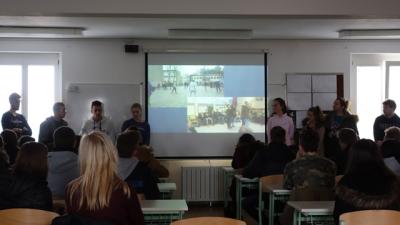


We all hope to visit Hamburg again.





... link (0 Kommentare) ... comment
Sonntag, 24. Dezember 2017
Season`s Greetings
beekids, 12:13h
Our dear friends,
We are wishing you all the blessings of a wonderful Christmas time and we hope you feel all the joys the season brings.
Merry Christmas and a wonderful New Year!
Friends from Maribor

We are wishing you all the blessings of a wonderful Christmas time and we hope you feel all the joys the season brings.
Merry Christmas and a wonderful New Year!
Friends from Maribor

... link (0 Kommentare) ... comment
Donnerstag, 14. Dezember 2017
Charity Bazaar at Biotechnical School Maribor
beekids, 13:47h
December is the part of the year that fills our hearts with warmth and homeliness, good will. Teachers and students of our school stepped together and joined forces in the desire to do something good. Good for people and also good for our animal friends. The money collected at the school charity bazaar goes into a school fund, that helps students from socially disadvantaged families. Part of the money, food and other necessary aids are donated to the abandoned and wildlife animals every year.
School kitchen was full of joyful smiles from students, who tried to prepare delicious products. They were sold at the bazaar. Although the heating was out of order and there was electricity shortcut, we had fun and successful production.
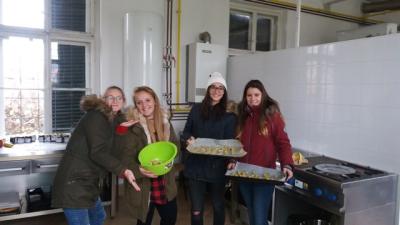
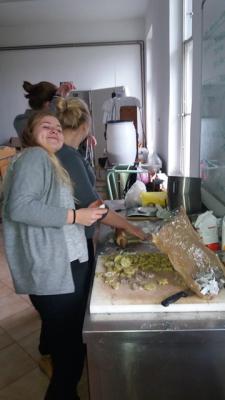
In the second workshop, the students prepared sunflower seeds and bird cakes,for birds which don't fly south and stay the winter with us.
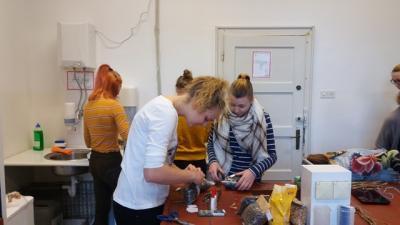

Our florist prepeared tea bags, herbal baths, herbal blends and fragrant bouquets. In the classroomand the hall smelled like in grandmother's herbal chamber.
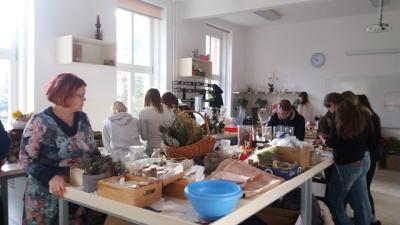


During the beekeeping lesson, we made candles and ornaments from wax.
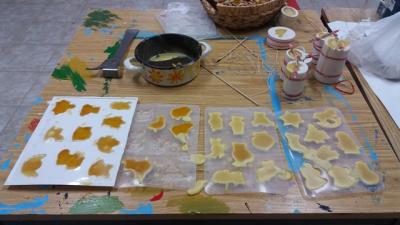
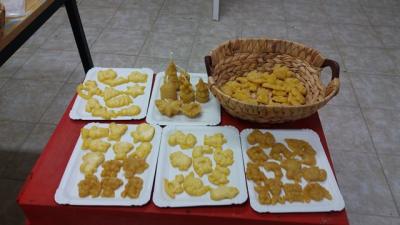
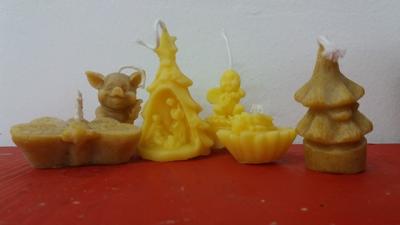
Teachers also contributed their own, unique products.

Our two wooden pyramids were full of wonderful gifts.

In the wooden honeycomb, which is the result of careful and precise work of our school caretaker/janitor Ivan, the Fairtrade products and products that students made, were exhibited.


We also prepared herbal tea with honey and lemon, scented coffee (Fairtrade) and some delicious desserts from pumpkin seeds, which were offered to teachers and parents.

We all joined together as one happy family. I wish that this Christmas spirit would last long after this Christmas season and the warmth in our hearts would keep us cheerful in these cold winter days and that our friendship would help us to achieve our important mutual goals.
School kitchen was full of joyful smiles from students, who tried to prepare delicious products. They were sold at the bazaar. Although the heating was out of order and there was electricity shortcut, we had fun and successful production.


In the second workshop, the students prepared sunflower seeds and bird cakes,for birds which don't fly south and stay the winter with us.


Our florist prepeared tea bags, herbal baths, herbal blends and fragrant bouquets. In the classroomand the hall smelled like in grandmother's herbal chamber.



During the beekeeping lesson, we made candles and ornaments from wax.



Teachers also contributed their own, unique products.

Our two wooden pyramids were full of wonderful gifts.

In the wooden honeycomb, which is the result of careful and precise work of our school caretaker/janitor Ivan, the Fairtrade products and products that students made, were exhibited.


We also prepared herbal tea with honey and lemon, scented coffee (Fairtrade) and some delicious desserts from pumpkin seeds, which were offered to teachers and parents.

We all joined together as one happy family. I wish that this Christmas spirit would last long after this Christmas season and the warmth in our hearts would keep us cheerful in these cold winter days and that our friendship would help us to achieve our important mutual goals.
... link (0 Kommentare) ... comment
Sonntag, 10. Dezember 2017
Raised garden bed in Rissen
meadowkids.eu, 11:57h
The week with students from Maribor gave us a lot of new material to learn. We learn not only to meet them, some new words:), friends, how to work in a area of gardening, apple chips, potato chips ... With their energy we finally have raised garden bed!
Check the fotos!
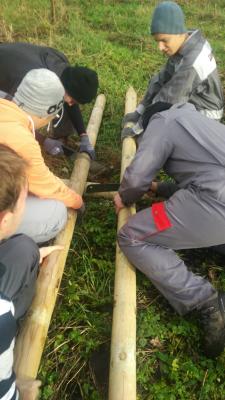


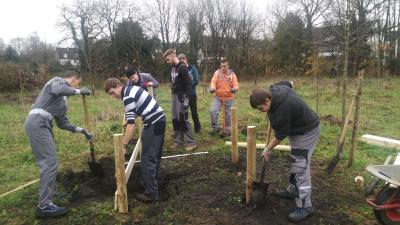

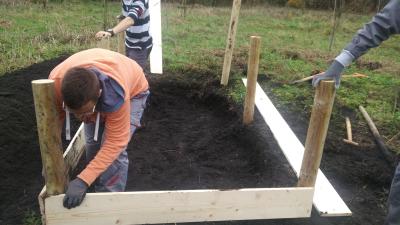

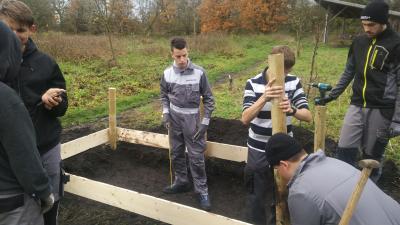
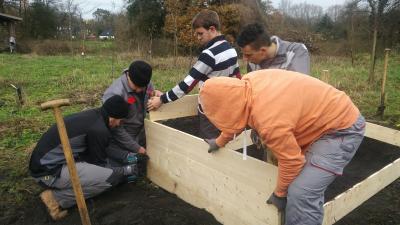
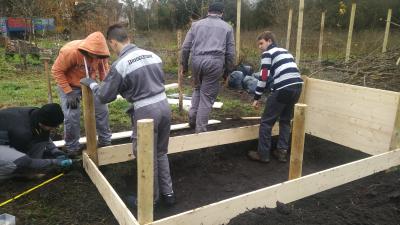
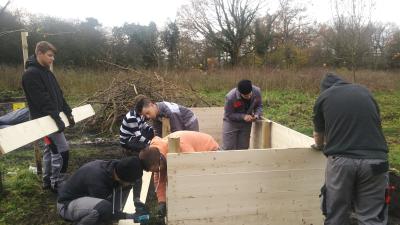
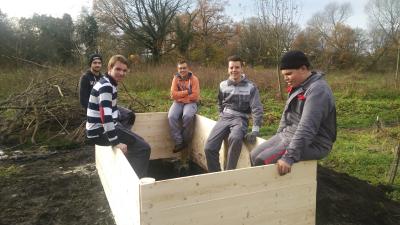

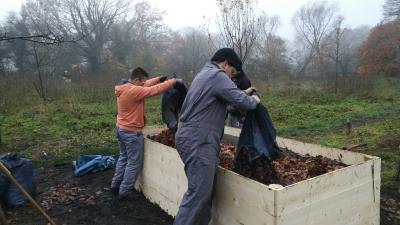
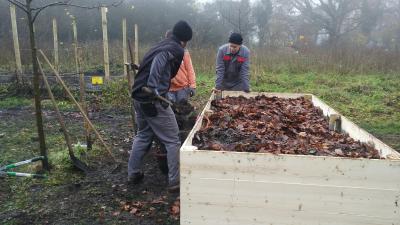
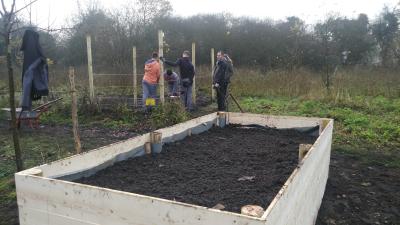
Check the fotos!
















... link (0 Kommentare) ... comment
Freitag, 8. Dezember 2017
Teacher (Kristina Dolinar Paulič) about project
beekids, 22:29h
I've been employed for 11 years at the Biotechnical School Maribor and I've always liked to take on new challenges and come up with crazy ideas. One of them was also bees. When we renovated the old beehive at home and started to be beekeepers, I also had an idea of having bees at school. The hives were set up and the bees flew around and Simon invited me to participate in the project We can bee friendlier to the nature. One day in May Simon introduced me to our new friends Polona and Sven from the cooperating school. Although we only saw each other for a short time, they made a good impression on me. Perhaps it was because of the queen bee, that I was going to insert into the hive that day. It was a good sign. In this year of beekeeping I have realized that bees carry out a lot of useful tasks - among other things, they bring people together.
Short after the meeting of the teachers and principals from Hamburg Simon invited me to the November exchange. I was happy and I am waiting for another unforgettable experience.
On Monday, 20th November, 2017, we drove away with two vans to the airport to Venice. The ride passed quickly by the sounds of entertaining folk songs. The flight was pleasant, and even more pleasant was the reception of students and teachers at the airport. It was followed by a joint dinner, an introduction day, the preparation of products for the market, fun afternoons. We learned languages and got to know each other quite well . We found out that together we could achieve more. There were new ideas, improvements, and our products were growing faster. On Saturday, the market place was full of products. Students were very good at selling. They also made a great raised bed garden. The most important are new friendships between our students. As a teacher I can be proud of all our students. They are reliable. They did everything and much more than we'd expected.
The week passed too fast and we had to go home. Thanks to modern technology and social networks, we have stayed in touch. We can exchange new ideas and experiences.
Thank you all, who helped to organize this week, as great as it was. Thanks for hospitality, advice,cooperation, fellowship and drinks. Thank you all, Polona, Simon, Jolanda, Marcus and especially to Sven. Thank you for all your time, which was spent only for us. Together we can make great products and amazing things happen.
“So work the honey bees. Creatures that, by a rule in Nature, teach the art of order to a peopled kingdom.” (William Shakespeare)
Short after the meeting of the teachers and principals from Hamburg Simon invited me to the November exchange. I was happy and I am waiting for another unforgettable experience.
On Monday, 20th November, 2017, we drove away with two vans to the airport to Venice. The ride passed quickly by the sounds of entertaining folk songs. The flight was pleasant, and even more pleasant was the reception of students and teachers at the airport. It was followed by a joint dinner, an introduction day, the preparation of products for the market, fun afternoons. We learned languages and got to know each other quite well . We found out that together we could achieve more. There were new ideas, improvements, and our products were growing faster. On Saturday, the market place was full of products. Students were very good at selling. They also made a great raised bed garden. The most important are new friendships between our students. As a teacher I can be proud of all our students. They are reliable. They did everything and much more than we'd expected.
The week passed too fast and we had to go home. Thanks to modern technology and social networks, we have stayed in touch. We can exchange new ideas and experiences.
Thank you all, who helped to organize this week, as great as it was. Thanks for hospitality, advice,cooperation, fellowship and drinks. Thank you all, Polona, Simon, Jolanda, Marcus and especially to Sven. Thank you for all your time, which was spent only for us. Together we can make great products and amazing things happen.
“So work the honey bees. Creatures that, by a rule in Nature, teach the art of order to a peopled kingdom.” (William Shakespeare)
... link (0 Kommentare) ... comment
Samstag, 2. Dezember 2017
Beekeeping at Biotechnical school Maribor
beekids, 22:02h
In the school year 2016/2017 at the Biotechnical School Maribor we decided to raise the beekeeping tradition. In order to make the work easier, I registered a class at the Beekeeping Association of Slovenia. At the beginning we needed the beekeeping equipment. Some equipment was provided by the Beekeeping Association and the other was provided by the school. When we collected all the necessary equipment, we could start. Of course, with the best team: Ivan, Jakob and Mihej.

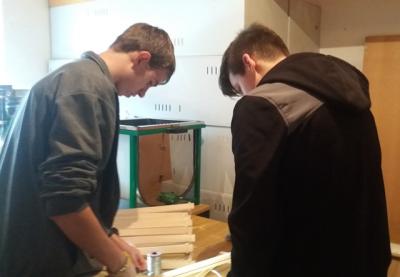

By the May 2017, we prepared all the necessary equipment for settlement the bees. The girls also joined the guys. They painted beehives.
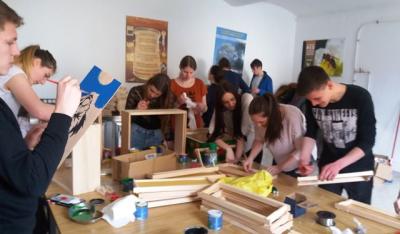
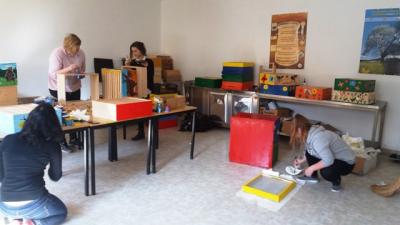
Together they won a silver recognition award at the beekeeping competition.
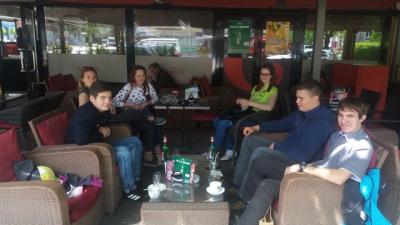
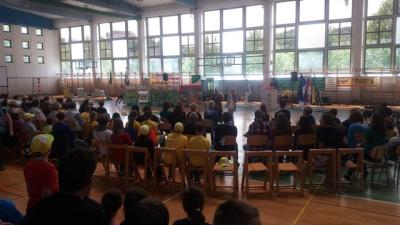
On 4th May first three families were brought to school
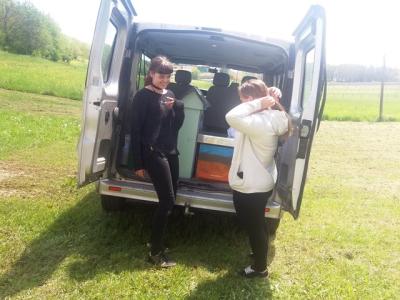

and on 23th another three.
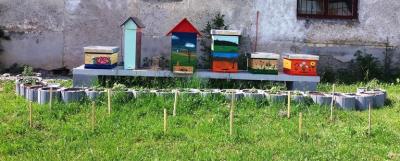
We didn`t have any honey with young families this year, but they successfully contributed to pollinating plants. In the autumn time, we fed the bees, we treated them against Varoa and prepared them for the winter.
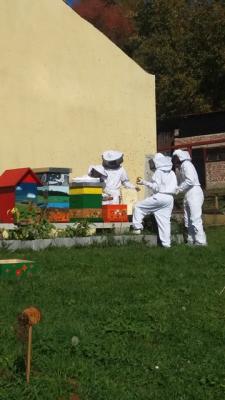
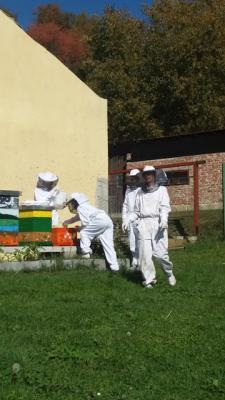




By the May 2017, we prepared all the necessary equipment for settlement the bees. The girls also joined the guys. They painted beehives.


Together they won a silver recognition award at the beekeeping competition.


On 4th May first three families were brought to school


and on 23th another three.

We didn`t have any honey with young families this year, but they successfully contributed to pollinating plants. In the autumn time, we fed the bees, we treated them against Varoa and prepared them for the winter.



... link (0 Kommentare) ... comment
Donnerstag, 30. November 2017
Youth Exchange Poll
meadowkids.eu, 11:41h
Was the "Youth Exchange" week interesting, exiting, etc...?
... link (0 Kommentare) ... comment
... older stories